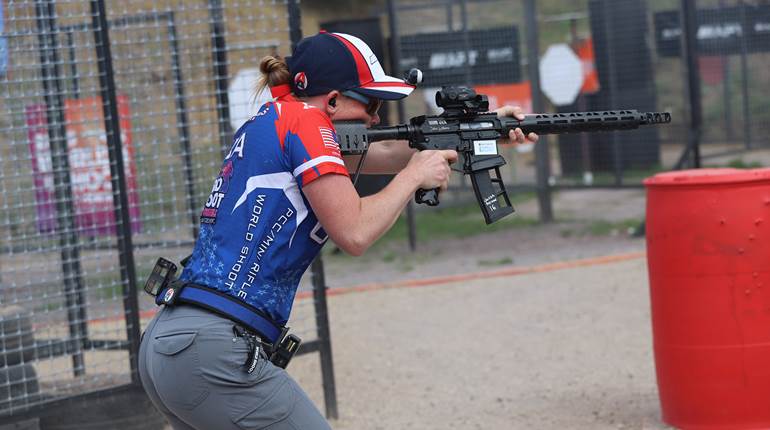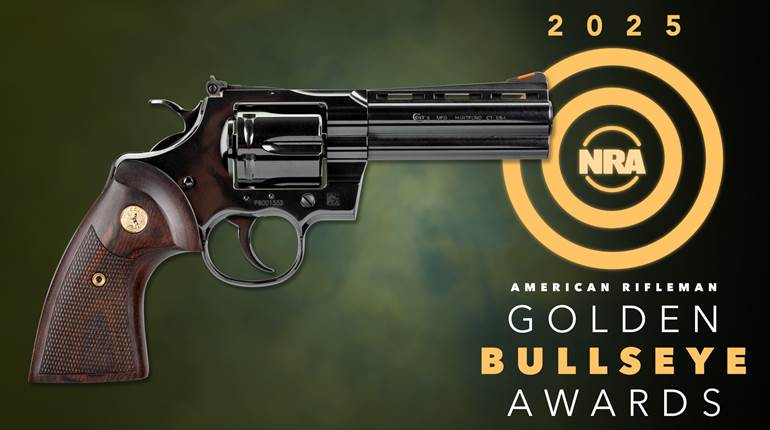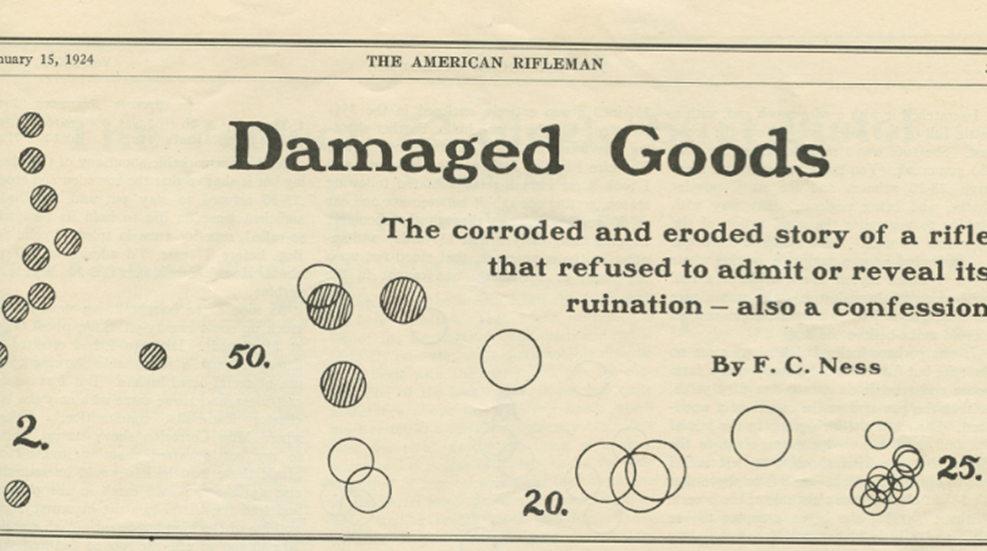
The corroded and eroded story of a rifle that refused to admit or reveal its ruination-also a confession.
By F.C. Ness
I can't understand your attitude. You say you find it shoots O.K. and like the way it handles, and is just the kind of pistol you are looking for and still wouldn't think of owning it? Sounds pretty inconsistent. But let me give you a tip. If you want a .22 Colt Automatic you'll be foolish to pass this one up at $25. Why, man! I couldn't lay my hand on a new one today for love or money, and if the miracle happened it would cost you all of fifty smackers."
The gun store proprietor leaned over his show-case eagerly, holding the gun under discussion in his two hands as he addressed me. What he said was true. In my week's try-out I had discovered that the little second-hand automatic possessed excellent handling and shooting qualities. But-and here we come to the reason for this recrudescence of wartime market conditions-the gun was marked, scratched, worn and the barrel, while it shot well enough, was not in perfect condition as to bore, and I was a little skeptical. I had too long been the victim of magazine writers to accept without a qualm of doubt or misgiving anything short of perfection in the gun line. I was afraid the little .22 would develop rough spots, eventually leading to pitting. So I shook my head.
A friend who had entered the store with me came to my defense.
"Art," he said, addressing the gun dealer, "you ought to know Ness better than that. He's a regular bug, and you should see how perfect he keeps his guns. If you did you wouldn't try to even give him an arm that looks like this abused little Colt."
This label my friend pasted on me assayed 100 per cent pure, and, at the time, tickled my vanity not a little. Now vain-glory is good stuff in its proper place, but when it becomes so pronounced as to subordinate plain horse-sense, avoid it brother-drop it like a counterfeit coin. You see I had been the victim of my own credulity, and was an easy prey for all this here now propaganda published yearly, monthly, weekly, by our experts, authorities and others in the national shooting compendium. Then something happened that opened my eyes, and I became more discerning, learned to do a little judicial gleaning of the tares from month the wheat. You see, even the most highly touted are human, and it is human to err; and I am sure even Whelen sometimes publishes stuff in good faith under his name that, in light of later knowledge, bothers his conscience. Perhaps the same might be said of Crossman (whom I greatly admire) if he's got one.
And it came to pass that something jarred away the clouds of fear and brightened up my 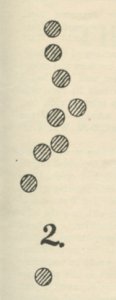 perspective until I could see the truth, and one by one, shed the old superstitions. Like the time we came out on the road with a partridge, three squirrels, and five rabbits, and encountered the sign, "No Hunting Here!" It was the case of another lie nailed. Chauncey Thomas is doing it right along. He finds: he can mix, satisfactorily, black and smokeless; he can use Schuetzen in his Peacemaker and black powder in modern high powers with good results; he can accomplish this "impossible" and finds that "inadvisable" a good bet. Myself, I find that not only can I load 25 grains bulk of Schuetzen in my .45 S.A. more conveniently and safely than the revolver and pistol powders, but that it shoots fully as accurately and has some advantages not possessed by the other loads. Also that I can break down a Western Super X .12 gauge shell and load its (about) 40 grains of Du Pont No. 93 in 5.5-grain charges (by weight) in my .45 Auto and with a 10-1 Ideal alloy bullet, 452374, can shoot into the Standard American "ten" ring at twenty yards with the combination. Another thing experience has taught me is that I can shoot Hercules nitroglycerine, Du Pont bulk, and Du Pont nitrocellulose dense, smokeless powders in the new barrel of my Peacemaker without cleaning for several months and still retain the Colt polish bore. And last of all that the mere fact a rifle barrel is damaged or spoiled doesn't necessarily mean it is ruined. But there is one thing at which both C.T. and yours truly draw the line-we do not advise the tyro, the beginner, or the lay-man if you please, to venture out among our own whirlpools until he has learned to swim-because all this is utterly unorthodox. Too well we know the dangers that beset the amateur shooter-I, myself, have blown up a perfectly good six-gun with Du Pont's recommended charge of No. 3 powder.
perspective until I could see the truth, and one by one, shed the old superstitions. Like the time we came out on the road with a partridge, three squirrels, and five rabbits, and encountered the sign, "No Hunting Here!" It was the case of another lie nailed. Chauncey Thomas is doing it right along. He finds: he can mix, satisfactorily, black and smokeless; he can use Schuetzen in his Peacemaker and black powder in modern high powers with good results; he can accomplish this "impossible" and finds that "inadvisable" a good bet. Myself, I find that not only can I load 25 grains bulk of Schuetzen in my .45 S.A. more conveniently and safely than the revolver and pistol powders, but that it shoots fully as accurately and has some advantages not possessed by the other loads. Also that I can break down a Western Super X .12 gauge shell and load its (about) 40 grains of Du Pont No. 93 in 5.5-grain charges (by weight) in my .45 Auto and with a 10-1 Ideal alloy bullet, 452374, can shoot into the Standard American "ten" ring at twenty yards with the combination. Another thing experience has taught me is that I can shoot Hercules nitroglycerine, Du Pont bulk, and Du Pont nitrocellulose dense, smokeless powders in the new barrel of my Peacemaker without cleaning for several months and still retain the Colt polish bore. And last of all that the mere fact a rifle barrel is damaged or spoiled doesn't necessarily mean it is ruined. But there is one thing at which both C.T. and yours truly draw the line-we do not advise the tyro, the beginner, or the lay-man if you please, to venture out among our own whirlpools until he has learned to swim-because all this is utterly unorthodox. Too well we know the dangers that beset the amateur shooter-I, myself, have blown up a perfectly good six-gun with Du Pont's recommended charge of No. 3 powder.
Well, the upshot of the whole confusing jangle that precedes is that I always had looked with horror upon any rifle that did not display a spotless and shiny interior, until-Miller bought a .25-20 Marlin trombone at a farmer auction, traded it for a model '92 Winchester of the same caliber and $15.00 to boot, and borrowed ten bucks from me and wished the lever action on me "for security" he said. I looked at its factory iron-sights and snorted in disgust. The "front" bent, dented, and shiny-edged; the "rear" in need of dehorning. Then I stuck a reflector in the receiver-well and saw,-pits. They had been poorly camouflaged with vaseline or goose fat. "Alright!" I said, and shoved the thing up into an obscure corner of the attic, where stood a rusted and forgotten Winchester, a relic of 1873. I had not the faintest intention of ever again handling that horribly mutliated .25-20 rifle. From time to time, other members of the household used it, and set it back without cleaning, and forgot it.
Came a bitterly cold blustery day, a successor to colder and still more windy days that had 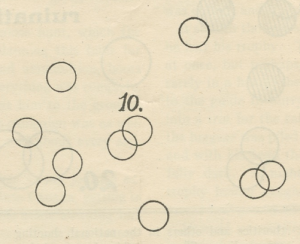 ushered it in over the week. I was bored with ennui and inaction and had to get out on my skis. There is nothing like a seven-mile battle with the elements to clear away the blues, especially if you can tote a rifle for a companion. But the only ammunition available was a box of .25's for that abused rifle up in the attic. I hesitated, gloomily uncertain, and then, remembering we had gotten partly used to substitutes for flour, I went up into the attic and brushed the cobwebs off.
ushered it in over the week. I was bored with ennui and inaction and had to get out on my skis. There is nothing like a seven-mile battle with the elements to clear away the blues, especially if you can tote a rifle for a companion. But the only ammunition available was a box of .25's for that abused rifle up in the attic. I hesitated, gloomily uncertain, and then, remembering we had gotten partly used to substitutes for flour, I went up into the attic and brushed the cobwebs off.
I scratched it with a wire brush and, with a kettle full of hot water, washed out the loose rust. She sure was a sight to sicken the eyes of a gun crank. You know how it is with these large .25-20 primers and the small powder charge, and being neglected that way with nothing to neutralize the acrid action of the potassium chloride. I don't believe there was an unaffected square molecule in the whole bore. I called myself seven kinds of a fool for lugging it along, but it really was a nice handling gun and I had a good imagination, so I could make-believe the rest.
It was perhaps lucky I sighted no game on the trip, but five miles out I stopped at a farm house and tried it on a target at fifty yards, holding the gun against the corner of a wood-shed. She made a 4-inch group to the left of the bull, and I moved the rear-sight to the right. But she kept shooting to left and I had to move the "front" to left or shove that hind-sight clean off the right side of the breech. Without warning she began grouping to the right and a little higher, and I had the same trouble all over again, this time on the reverse. I have up, but my curiosity was aroused. I moved the "front" back over center, and the "rear" as near the middle as I could judge and took one parting shot before starting for home-this time offhand. And I hit the bull! A low "eight."
On the back trail I pondered the matter. It couldn't be the rifle or she would have scattered more. Looked more like the ammunition, but it had grouped pretty consistently into a 4 or 5 inch. Maybe it was the wood-shed. For luck I took a shot at a small clod 85 yards ahead, and busted it. Then one at about 150 yards. It was a nice judge of distance. "Hmmmm!" I thought. "Maybe the old thing is whimsical. Probably she'll treat me better from my high-horse." And she did! I'm here to tell you that.
When I reached home I had forgotten my blues and become absorbed with the task of 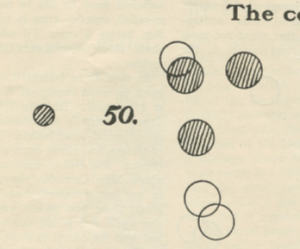 cleaning out that fouled rifle tube. I tried everything I could think of-kerosene, gasoline, Gold Dust, Dutch Cleanser, washing powder, powder solvents, rust removers, ammonia dope, soldering acid, Crystal Cleaner, hair tonic, steel wool, wire brushes, pumice stone, and, in fact, anything short of a valve-grinding compound. I believe I did improve it some, but those pits were too deeply rooted to be obliterated by anything short of reboring to some larger caliber. In addition to the corrosion that extended from hammer to muzzle, the breech-end was eroded up to midway. It is impossibly to adequately describe the pitiful state of these grooves, and the lands were but little better. But, near the muzzle they were sharp and clear as to edge where the pits had not cross-cut them. There was no trouble getting the action in shape, and I replaced the factory make-shifts with an Improved "front" (Marbles) and King's No. 10 flat-top sporting rear.
cleaning out that fouled rifle tube. I tried everything I could think of-kerosene, gasoline, Gold Dust, Dutch Cleanser, washing powder, powder solvents, rust removers, ammonia dope, soldering acid, Crystal Cleaner, hair tonic, steel wool, wire brushes, pumice stone, and, in fact, anything short of a valve-grinding compound. I believe I did improve it some, but those pits were too deeply rooted to be obliterated by anything short of reboring to some larger caliber. In addition to the corrosion that extended from hammer to muzzle, the breech-end was eroded up to midway. It is impossibly to adequately describe the pitiful state of these grooves, and the lands were but little better. But, near the muzzle they were sharp and clear as to edge where the pits had not cross-cut them. There was no trouble getting the action in shape, and I replaced the factory make-shifts with an Improved "front" (Marbles) and King's No. 10 flat-top sporting rear.
Lying prone on my blanket, I proceeded to lambast an 8-inch pistol bull at 70 yards (seventy) and, after doing a little sight adjusting, I fired a ten-shot string to decide the fate of the rifle. Imagine my surprise to find a 2 1/2-inch group entirely enclosed in the 3 1/4-inch center of the 8-inch bull. Further shooting convinced me it was not a freak string. The nice handling little weapon had won, and I took it on a small-game hunt the following season, getting one rabbit between eye and ear at 50 yards; and one through the shoulders hopping along easly-like at 25 yards; and another at the same range, that stood not upon the order of his going, was caught in the rear as he disappeared over a rise. I also picked off a squirrel from a high cotton-wood as neatly as could be done with any rifle no matter what its condition.
Beckler, who claimed a Sharpshooter's badge while in Company B, had a 25-35 Win. in fine condition, and the Waterloo of several Wyoming coyotes. He glanced into my .25-20 and pronounced it worthless. You see he had been prejudiced as had I. To show him how wrong his conclusions were, I challenged him to five shots offhand, and five prone at 175 yds. on the C-5 Target.
Result:
1. Worthless .25-20
Offhand: 20x25
Prone: 23x25
Total: 43
2. Perfect .25-35
Offhand: 17x25
Prone: 22x25
Total: 39
Before beginning the competition we sighted in on a 200-yard Standard American target at the same range of course. After getting in the "black," the damaged .25-20 ran five straight. My eight sighting shots running as follows: 4, 7, 7, 9, 8, 10, 9, 10.
At another time Ech and I fought it out with seven shots on the C-5 Target at 150 yds. My friend and neighbor, judging by his interest in my magazines, is a gun crank as well. He has a .25 Remington automatic and knows how to take care of it besides shooting it. One fourteen-shot salvo ended as follows:
1. Damaged .25-20
Sitting: 22x25
Standing: 6x10
Total: 28x35
2. Fine Rem .25 riml's
Sitting: 17x25
Standing 10x10
Total: 27x35
Nothing remarkable about any of this shooting but it showed that the corroded and eroded .25-20 refused to stay put and still had a sufficient lease on life to hold its own with so-called, superior arms in splendid condition. But, before I cease, I'd admire to tell you about Howe's brand-new .25-20 Winchester carbine.
As soon as he bought it, we went out and stuck up some twenty-yd. S.A. pistol targets at 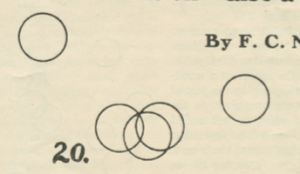 fifty yards. Hitherto I had credited my damaged barrel's remarkable showing to the use of metal-cased bullets. But I ran out of cartridges, and Howe came with only the Winchester lead-bullet ammunition. "Here's where Miss Corrosion shows us up," I said to my battle-scarred shooting iron. I was afraid those lead bullets would be something else again and would catch in the pit holes and lead the barrel to swift inaccuracy. But nothing of the kind happened. With scores of 20x30 and 15x30 the spoiled gun bested the brand-new carbine of same make, model, and caliber, 14x30 and 17x30 or by a total of four points. We shot a great many shots at miscellaneous targets, but the "corroded on" refused to become leaded, as I could find no trace of it when I examined the bore. To settle the question, I leaned the gun over a rigid fencepost and fired a five-shot group at fifty yards that could all be touched by a one-inch circle.
fifty yards. Hitherto I had credited my damaged barrel's remarkable showing to the use of metal-cased bullets. But I ran out of cartridges, and Howe came with only the Winchester lead-bullet ammunition. "Here's where Miss Corrosion shows us up," I said to my battle-scarred shooting iron. I was afraid those lead bullets would be something else again and would catch in the pit holes and lead the barrel to swift inaccuracy. But nothing of the kind happened. With scores of 20x30 and 15x30 the spoiled gun bested the brand-new carbine of same make, model, and caliber, 14x30 and 17x30 or by a total of four points. We shot a great many shots at miscellaneous targets, but the "corroded on" refused to become leaded, as I could find no trace of it when I examined the bore. To settle the question, I leaned the gun over a rigid fencepost and fired a five-shot group at fifty yards that could all be touched by a one-inch circle.
The performance of the "ruined" .25-20 exploded a few theories and review some of my 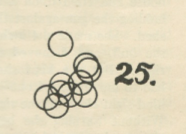 misconceptions about arms and ammunition to the point where I was willing to buy an obsolete .45 revolver through the D.C.M. The rust had roughened the bore making it harder to keep clean but it was not pitted, and I could put five shots on a playing card and ten in a row into a four-inch bull's eye at thirty feet with black-powder .45 S&W Schofield cartridges and better than that with Remington smokeless, Colt ammunition, after I had become accustomed to the handling of the gun. I also ventured to become the owner of a pawn-shop relic of the World War in the form of a .45 Colt Service pistol, sadly mutilated and rusty of interior. I found the latter to be a mere surface oxidation and, after a little simple gunsmithing, I found the automatic capable of 3-inch and 3 1/2-inch groups at 20 yds, offhand, and could stay in the S.A. pistol bull from a knee arm-rest. It is not as good as a .22 pistol for fine short range targets, but I have a great amount of fun with it at long range. Only a week ago I surprised my companions by hitting a 6x6-inch rock at 100 estimated yards the first attempt, and by landing three of a magazine full on a larger slab of limestone clear across the valley; fully 150 yards, and probably many farther. At the range it is no trick to keep a narrow stream splashing until your arm tires.
misconceptions about arms and ammunition to the point where I was willing to buy an obsolete .45 revolver through the D.C.M. The rust had roughened the bore making it harder to keep clean but it was not pitted, and I could put five shots on a playing card and ten in a row into a four-inch bull's eye at thirty feet with black-powder .45 S&W Schofield cartridges and better than that with Remington smokeless, Colt ammunition, after I had become accustomed to the handling of the gun. I also ventured to become the owner of a pawn-shop relic of the World War in the form of a .45 Colt Service pistol, sadly mutilated and rusty of interior. I found the latter to be a mere surface oxidation and, after a little simple gunsmithing, I found the automatic capable of 3-inch and 3 1/2-inch groups at 20 yds, offhand, and could stay in the S.A. pistol bull from a knee arm-rest. It is not as good as a .22 pistol for fine short range targets, but I have a great amount of fun with it at long range. Only a week ago I surprised my companions by hitting a 6x6-inch rock at 100 estimated yards the first attempt, and by landing three of a magazine full on a larger slab of limestone clear across the valley; fully 150 yards, and probably many farther. At the range it is no trick to keep a narrow stream splashing until your arm tires.
In conclusion, I will say that I decided to adopt the despised .25-20 into my family as the one exception that proves the rule. But in an unfortunate moment of braggadocio I let Miller know what a good performer his '92 Winchester was, and now Miller has the gun, and I've spent the returned ten bucks on a new SS pistol that pleases me not nearly as well. No, you never can tell. Appearances are oftimes deceitful.
Moral: Avoid all foreign junk, post-war German Lugers and Mausers, and other weapons of questionable quality no matter how pleasing their exterior finish. Such ilk are in no wise superior to our less pretentious Iver-Johnsons, and Hamiltons, and Fullertons, and Harrington & Richardsons. On the contrary, they are inferior to our cheaper grade of American arms because we know what to expect of the later kind and shall not be misled into attempting things with them that can only be met by standard arms of high quality.
If the price of high-grade guns is an obstacle, it would be of questionable wisdom to invest 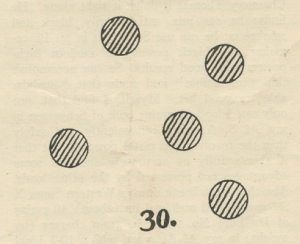 your money in arms that are nice to look at but rotten at heart, even if the only alternative is a second-hand gun. Such firearms, by our own manufacturers,a s the Winchester, Remington, Savage, Stevens, Marlin, Smith & Wesson, and Colt give surprising service, (often) even after being sadly abused, because they are sound at the core. Besides, they have the saving grace of being much safer than the cheaper grades.
your money in arms that are nice to look at but rotten at heart, even if the only alternative is a second-hand gun. Such firearms, by our own manufacturers,a s the Winchester, Remington, Savage, Stevens, Marlin, Smith & Wesson, and Colt give surprising service, (often) even after being sadly abused, because they are sound at the core. Besides, they have the saving grace of being much safer than the cheaper grades.
And if it is a bargain you are after looking' for why just take a squint at the diagrams of typical groups shot with six second-hand guns, and note the bargain prices, at which they were bought. None of these guns was or is perfect, and some quite the opposite, others in various stages of erosion, pitting and corrosion, and each was secured at a sacrifice price. The targets are not freaky or lucky, but represent the every-day performance of the gun. The group-designation-figure in each case is placed squarely upon the point of aim,-numbers 50, 20 and 30 are at six o'clock, or the bottom edge of the bull,-numbers 10, 25 and 2 in centre of bull's eye.
Group No. 10 shows ten shots in 2 1/2-inch within the 200 yard "ten-ring" with the corroded .25-20 model '92 Winchester mentioned in text. Seven of them would cut a 1 3/8-inch circle. Remington metal-cased bullets used, and shot at seventy yards, prone. With Winchester lead bullets, five shots from rest and kneeling position could all touch a one-inch ring at fifty yards. Gun cost $10.
Group No. 25 shows ten shots at twenty-five yards with a second-hand Winchester model '90, calibre. 22 W.R.F. that cut a 3/8-inch circle. Marbles tang-sight and Lyman shaded pin-head, chair, table and sand bag were used. Gun was secured by trading, even, one Sears & Roebuck .16-gauge, single-barrel.
Group No. 2 shows ten shots at twenty yards from a worn and pitted Stevens Lord's model .22 caliber pistol, pin-head front and Simplex peep from sitting position using two hands. Peep bar was raised five times during the string. Nine shots would hit a Dixon's copy pencil, and eight of them an Omar cigarette. Only one unaccountable, 3/4-inch to the right. This Stevens was fourth- or fifth-handed and cost me $5.00. Peters Semi-L.R. used.
Group No. 50 shows six shots by two shooters (F.C.N. and H.S.N.) on the same target at fifty yards, sitting, with a second-hand .32-40 mod' '1894 Winchester. Remington 98-gr. Mid-Range was used. This gun served me well at turkey shoots, scored 46x50 at 200 yards and at 100 yards with 1742 f.s., metal-cased ammunition, could put ten shots into a 2 1/4-inch circle any old time from the prone position. It cost me $6.00.
Group No. 20 shows five shots at twenty yards with an abused junk-shop .45 A.C.P. Seated, one hand, arm rested on knee. Ideal bullet, 452374, and six grains of DuPont No. 3 powder used. From this position a magazine-full of store cartridges can be kept on the twenty-yard S.A. bull. Best offhand score secured at this range, 93x100 with gun mentioned in text. Targets shot with the D.C.M. (War Department) .45 Colt revolver were not included because they were published in another magazine in 1921.
Group No. 30 shows five shots at thirty feet with a rusted secondhand .380 Remington pistol, model 51, strictly offhand. A very easy performance with this gun and Rem-U.M.C. ammunition. Three "10's" and two "8's" on S.A. 20-yard bull. Gun cost $10.00.
With a given amount of coin to invest 'tis honest mule sense tells us that one of the second-hand "Standard Makes" is as good a gamble as any. And 'tis but vain glory that prompts us to throw in with a shining barrel that really is made of pot-metal.













